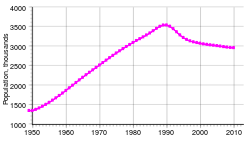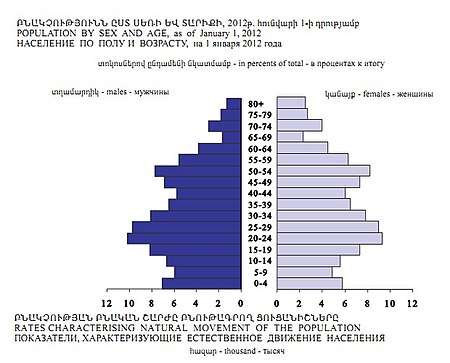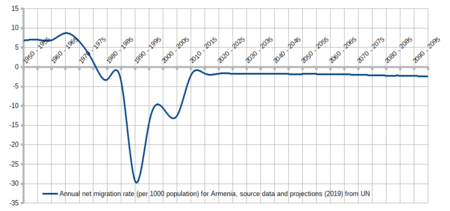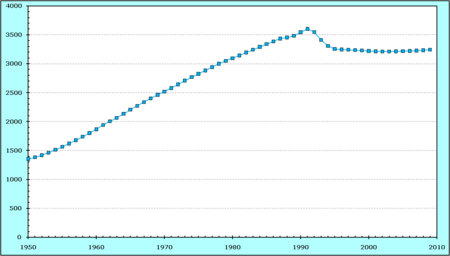Demographics of Armenia
After registering a steady increase during Soviet period, the population of Armenia declined from peak value 3.633 million in 1992 to 2.986 million in 2017.[1]
| Demographics of Armenia | |
|---|---|
 Population of Armenia (in millions) from 1949 to 2010. | |
| Population | 3,046,100 (7 November 2018)[1] |
| Density | 102.73/km2 |
| Growth rate | 0.27/1,000 population (2016 est.) |
| Birth rate | 2.97 births/1,000 population (2014 est.) |
| Death rate | 1.76 deaths/1,000 population (2014 est.) |
| Nationality | |
| Nationality | Armenian(s) |
| Major ethnic | Armenian |
| Minor ethnic | Russian, Yazidis, Kurds, Assyrian people |
| Language | |
| Official | Armenian |
| Spoken | Armenian, English, Kurdish, Russian, French and others |
The country's population has declined due to increased emigration since the break-up of the Soviet Union. The rates of emigration and population decline, however, have decreased in recent years, and there has been a moderate influx of Armenians returning to Armenia.

| Year | Pop. | ±% |
|---|---|---|
| 1831 | 161,747 | — |
| 1873 | 496,140 | +206.7% |
| 1897 | 797,853 | +60.8% |
| 1926 | 878,929 | +10.2% |
| 1939 | 1,282,338 | +45.9% |
| 1959 | 1,763,048 | +37.5% |
| 1970 | 2,491,873 | +41.3% |
| 1979 | 3,037,259 | +21.9% |
| 1989 | 3,304,776 | +8.8% |
| 2001 | 3,213,011 | −2.8% |
| 2011 | 3,018,854 | −6.0% |
| For 1831 and 1897[2] For 1873[3] | ||
Human development
According to 2018 HDI statistical update (with data for 2017) compared to all its neighboring countries Armenia has:
- the lowest coefficient of human inequality,
- the lowest gender inequality (ranked 55th on Gender Inequality Index),
- highest percentage of men and highest percentage of women with at least some secondary education,
- highest share of seats in parliament held by women,
- highest share of women who reported to feel safe,
- highest GDP growth rate.[4]
Since 1990 Armenia recorded steady growth of average annual HDI scores in every reported period (1990–2000, 2000–2010, 2010–2017).[4]
According to 2016 Sustainable Society Index Armenia has higher rank of Human Wellbeing than all its neighbours. At the same time its Economic Wellbeing rank is below neighbouring countries.[5]
2011 census counted 539 394 persons (19.4% of population above 6 years age) with higher professional education.[6]
Vital statistics
Life expectancy
According to 2018 HDI statistical update compared to all its neighboring countries Armenia has highest health expenditures as percentage of GDP and highest healthy life expectancy at birth.[4]
In 2016 the average life expectancy at birth for males was 71.6 years and for females was 78.3 years, with the average at 75.0 years.[1]
After a setback during 1986–1996 mostly due to the Spitak Earthquake and the Nagorno-Karabakh War, Armenia regained its position and was consistently among the top three former Soviet republics during 1997–2016, topping the list in 2007.[7]
During the Soviet period, life expectancy was traditionally high in Armenia and topped all other republics of USSR and most of countries in Eastern Europe in 1978–1980.[8][9]
| Period | Life expectancy in Years |
Period | Life expectancy in Years |
|---|---|---|---|
| 1950–1955 | 62.8 | 1985–1990 | 68.4 |
| 1955–1960 | 64.9 | 1990–1995 | 68.1 |
| 1960–1965 | 67.0 | 1995–2000 | 70.2 |
| 1965–1970 | 69.2 | 2000–2005 | 72.4 |
| 1970–1975 | 70.8 | 2005–2010 | 72.7 |
| 1975–1980 | 70.6 | 2010–2015 | 74.0 |
| 1980–1985 | 70.9 |
Source: UN[10]
Reproduction indicators
| Global map of changes in population growth rates | |
|---|---|
In 2016 natural increase of population comprised 12 366 persons and the crude rate of natural increase made 4.1‰, per 1000 population, decreasing by 0.4 pro mile points compared to the previous year.[1]
After double-digit (in pro mile) crude natural increase rates during 1982–1992 these did not exceed 5.5 after 1998. At regional level slightly better situation is in Yerevan city, where the value of 5.5 is consistently being surpassed since 2009. Particularly weak is natural increase in Tavush and Syunik provinces, not much better off are Lori and Vayots Dzor provinces.[1]
Fertility Rate (TFR) (Wanted Fertility Rate) and CBR (Crude Birth Rate):[11]
| Year | CBR (Total) | TFR (Total) | CBR (Urban) | TFR (Urban) | CBR (Rural) | TFR (Rural) |
|---|---|---|---|---|---|---|
| 2000 | 13.9 | 1.7 (1.5) | 12.1 | 1.5 (1.3) | 16.3 | 2.1 (1.7) |
| 2005 | 14.6 | 1.7 (1.6) | 14.5 | 1.6 (1.6) | 14.9 | 1,8 (1,6) |
| 2010 | 14.0 | 1.7 (1.6) | 12.8 | 1.6 (1.5) | 16.2 | 1.8 (1.8) |
| 2015–2016 | 12.9 | 1.7 (1.7) | 12.7 | 1.7 (1.6) | 13.2 | 1.8 (1.8) |
Armenia's Total Fertility Rate at 1.6 was lowest in the region in 2017.[12] TFR is expected to stay at 1.6 in years 2015–2020, less from 1.7 in years 2010–2015.[4]
The mean age of mother at birth was 26.8 years and at first birth it was 24.7 years in 2016.[1] Adolescent birth rate as well as share of women married at age of 18 was lowest in Armenia compared to its neighboring countries.[4]
In 2016, infant mortality rate (in the first year of their life) was 8.6 ‰ per 1 000 live births.[1]
A study revealed that population growth rate changes were more favorable in Armenia than in its surrounding countries during 2005–2015.
Structure of the population
Mean age in 2016 : 36.2 years.[1]
36.3% of women who gave birth in 2016 had higher education.[1]

http://www.armstat.am
Structure of the population (12.10.2011, census):[13]
| Age Group | Male | Female | Total | % |
|---|---|---|---|---|
| Total | 1,448,052 | 1,570,802 | 3,018,854 | 100 |
| 0–4 | 110 565 | 97 007 | 207 572 | 6.88 |
| 5–9 | 96 429 | 83 500 | 179 929 | 5.96 |
| 10–14 | 95 458 | 83 179 | 178 637 | 5.92 |
| 15–19 | 117 938 | 115 137 | 233 075 | 7.72 |
| 20–24 | 143 897 | 148 337 | 292 234 | 9.68 |
| 25–29 | 132 109 | 139 820 | 271 929 | 9.01 |
| 30–34 | 108 114 | 114 891 | 223 005 | 7.39 |
| 35–39 | 89 073 | 98 348 | 187 421 | 6.21 |
| 40–44 | 82 502 | 94 462 | 176 964 | 5.86 |
| 45–49 | 98 064 | 112 996 | 211 060 | 6.99 |
| 50–54 | 109 294 | 125 238 | 234 532 | 7.77 |
| 55–59 | 80 989 | 96 769 | 177 758 | 5.89 |
| 60–64 | 56 189 | 71 410 | 127 599 | 4.23 |
| 65–69 | 28 020 | 37 353 | 65 373 | 2.17 |
| 70–74 | 44 041 | 63 637 | 107 678 | 3.57 |
| 75–79 | 30 734 | 44 643 | 75 377 | 2.50 |
| 80–84 | 18 662 | 30 244 | 48 906 | 1.62 |
| 85+ | 5 974 | 13 831 | 19 805 | 0.66 |
| Age group | Male | Female | Total | Percent |
|---|---|---|---|---|
| 0–14 | 302 452 | 263 686 | 566 138 | 18.75 |
| 15–64 | 1,018,169 | 1,117,408 | 2,135,577 | 70.74 |
| 65+ | 127 431 | 189 708 | 317 139 | 10.51 |
In 2016 households with up to four members prevailed in urban areas of Armenia with share of such households coming to 70.2% in urban communities compared to 60.1% in rural communities.[14]
From sixties of the past century Armenia has highest share of urban population among South Caucasus countries.[15]
Vital statistics summary data[16][17][18][19][20]
| Average population | Live births | Deaths | Natural change | Crude birth rate (per 1000) | Crude death rate (per 1000) | Natural change (per 1000) | Total fertility rate | Infant mortality rate (per 1000 births) | Life expectancy males | Life expectancy females | Life expectancy (total) | |
|---|---|---|---|---|---|---|---|---|---|---|---|---|
| 1950 | 1,354,000 | 43,414 | 11,525 | 31,889 | 32.1 | 8.5 | 23.6 | |||||
| 1951 | 1,378,000 | 49,790 | 12,482 | 37,308 | 36.1 | 9.1 | 27.1 | |||||
| 1952 | 1,415,000 | 53,845 | 12,916 | 40,929 | 38.1 | 9.1 | 28.9 | |||||
| 1953 | 1,454,000 | 51,025 | 14,007 | 37,018 | 35.1 | 9.6 | 25.5 | |||||
| 1954 | 1,504,000 | 57,995 | 12,301 | 45,900 | 38.6 | 8.2 | 30.4 | |||||
| 1955 | 1,564,000 | 59,477 | 13,763 | 45,714 | 38.0 | 8.8 | 29.2 | |||||
| 1956 | 1,616,000 | 62,119 | 12,286 | 50,000 | 38.5 | 7.6 | 30.8 | |||||
| 1957 | 1,671,000 | 66,862 | 14,101 | 52,761 | 40.0 | 8.4 | 31.6 | |||||
| 1958 | 1,732,000 | 71,213 | 14,089 | 57,124 | 41.1 | 8.1 | 33.0 | |||||
| 1959 | 1,796,000 | 72,211 | 13,968 | 58,243 | 40.2 | 7.8 | 32.4 | |||||
| 1960 | 1,867,000 | 74,825 | 12,675 | 62,150 | 40.1 | 6.8 | 33.3 | 4.63 | ||||
| 1961 | 1,942,000 | 72,377 | 12,496 | 59,881 | 37.3 | 6.4 | 30.8 | 4.27 | ||||
| 1962 | 2,005,000 | 69,505 | 13,297 | 56,208 | 34.7 | 6.6 | 28.0 | 4.17 | ||||
| 1963 | 2,064,000 | 67,382 | 12,046 | 55,336 | 32.6 | 5.8 | 26.8 | 4.11 | ||||
| 1964 | 2,133,000 | 64,454 | 12,415 | 52,039 | 30.2 | 5.8 | 24.4 | 3.98 | ||||
| 1965 | 2,205,000 | 62,969 | 12,582 | 50,387 | 28.6 | 5.7 | 22.9 | 3.91 | ||||
| 1966 | 2,273,000 | 61,594 | 12,445 | 49,149 | 27.1 | 5.5 | 21.6 | 3.69 | ||||
| 1967 | 2,337,000 | 57,031 | 12,622 | 44,409 | 24.4 | 5.4 | 19.0 | 3.55 | ||||
| 1968 | 2,401,000 | 57,503 | 12,231 | 45,272 | 23.9 | 5.1 | 18.9 | 3.46 | ||||
| 1969 | 2,462,000 | 56,203 | 12,782 | 43,421 | 22.8 | 5.2 | 17.6 | 3.20 | ||||
| 1970 | 2,518,000 | 55,694 | 12,844 | 42,850 | 22.1 | 5.1 | 17.0 | 3.17 | ||||
| 1971 | 2,580,000 | 58,188 | 12,518 | 45,670 | 22.6 | 4.9 | 17.7 | 3.18 | ||||
| 1972 | 2,644,000 | 59,313 | 13,730 | 45,583 | 22.4 | 5.2 | 17.2 | 3.07 | ||||
| 1973 | 2,708,000 | 59,593 | 14,102 | 45,491 | 22.0 | 5.2 | 16.8 | 2.92 | ||||
| 1974 | 2,770,000 | 60,419 | 14,276 | 46,143 | 21.8 | 5.2 | 16.7 | 2.82 | ||||
| 1975 | 2,826,000 | 62,866 | 15,498 | 47,368 | 22.2 | 5.5 | 16.8 | 2.79 | ||||
| 1976 | 2,883,000 | 65,065 | 15,688 | 49,377 | 22.6 | 5.4 | 17.1 | 2.72 | ||||
| 1977 | 2,943,000 | 65,830 | 15,813 | 50,017 | 22.4 | 5.4 | 17.0 | 2.61 | ||||
| 1978 | 3,001,000 | 66,698 | 16,465 | 50,233 | 22.2 | 5.5 | 16.7 | 2.46 | ||||
| 1979 | 3,051,000 | 69,786 | 17,125 | 52,661 | 22.9 | 5.6 | 17.3 | 2.38 | ||||
| 1980 | 3,096,000 | 70,324 | 17,124 | 53,200 | 22.7 | 5.5 | 17.2 | 2.33 | ||||
| 1981 | 3,144,000 | 73,682 | 16,659 | 57,023 | 23.4 | 5.3 | 18.1 | 2.31 | ||||
| 1982 | 3,194,000 | 74,225 | 17,469 | 56,756 | 23.2 | 5.5 | 17.8 | 2.26 | ||||
| 1983 | 3,243,000 | 76,436 | 18,369 | 58,067 | 23.6 | 5.7 | 17.9 | 2.35 | ||||
| 1984 | 3,292,000 | 79,767 | 19,043 | 60,724 | 24.2 | 5.8 | 18.4 | 2.44 | ||||
| 1985 | 3,339,000 | 80,306 | 19,581 | 60,725 | 24.1 | 5.9 | 18.2 | 2.56 | ||||
| 1986 | 3,387,000 | 81,192 | 19,410 | 61,782 | 24.0 | 5.7 | 18.2 | 2.58 | ||||
| 1987 | 3,435,000 | 78,492 | 19,727 | 58,765 | 22.9 | 5.7 | 17.1 | 2.55 | ||||
| 1988 | 3,453,000 | 74,707 | 35,5672 | 39,140 | 21.6 | 10.3 | 11.3 | 2.49 | ||||
| 1989 | 3,482,000 | 75,250 | 20,853 | 54,397 | 21.6 | 6.0 | 15.6 | 2.61 | ||||
| 1990 | 3,545,000 | 79,882 | 21,993 | 57,889 | 22.5 | 6.2 | 16.3 | 2.63 | ||||
| 1991 | 3,604,000 | 77,825 | 23,425 | 54,400 | 21.6 | 6.5 | 15.1 | 2.60 | ||||
| 1992 | 3,549,000 | 70,581 | 25,824 | 44,757 | 19.9 | 7.3 | 12.6 | 2.44 | ||||
| 1993 | 3,410,000 | 59,041 | 27,500 | 31,541 | 17.3 | 8.1 | 9.2 | 2.14 | ||||
| 1994 | 3,309,000 | 51,143 | 24,648 | 26,495 | 15.5 | 7.4 | 8.0 | 1.878 | ||||
| 1995 | 3,255,000 | 48,960 | 24,842 | 24,118 | 15.0 | 7.6 | 7.4 | 1.842 | ||||
| 1996 | 3,247,000 | 48,134 | 24,936 | 23,198 | 14.8 | 7.7 | 7.1 | 1.834 | ||||
| 1997 | 3,242,000 | 43,929 | 23,985 | 19,944 | 13.5 | 7.4 | 6.2 | 1.680 | ||||
| 1998 | 3,235,000 | 39,366 | 23,210 | 16,156 | 12.2 | 7.2 | 5.0 | 1.509 | ||||
| 1999 | 3,230,000 | 36,502 | 24,087 | 12,415 | 11.3 | 7.5 | 3.8 | 1.388 | ||||
| 2000 | 3,221,000 | 34,276 | 24,025 | 10,251 | 10.6 | 7.5 | 3.2 | 1.305 | ||||
| 2001 | 3,214,000 | 32,065 | 24,003 | 8,062 | 10.0 | 7.5 | 2.5 | 1.239 | ||||
| 2002 | 3,205,000 | 32,229 | 25,554 | 6,675 | 10.1 | 8.0 | 2.1 | 1.207 | ||||
| 2003 | 3,188,000 | 35,793 | 26,014 | 9,779 | 11.2 | 8.2 | 3.1 | 1.349 | ||||
| 2004 | 3,172,000 | 37,520 | 25,679 | 11,841 | 11.8 | 8.1 | 3.7 | 1.383 | ||||
| 2005 | 3,155,000 | 37,499 | 26,379 | 11,120 | 11.9 | 8.4 | 3.5 | 1.366 | ||||
| 2006 | 3,139,000 | 37,639 | 27,202 | 10,437 | 12.0 | 8.7 | 3.3 | 1.348 | 13.9 | 69.8 | 76.0 | 72.9 |
| 2007 | 3,122,000 | 40,105 | 26,830 | 13,275 | 12.8 | 8.6 | 4.3 | 1.417 | 10.9 | 69.8 | 76.1 | 73.0 |
| 2008 | 3,106,000 | 41,185 | 27,412 | 13,773 | 13.3 | 8.8 | 4.4 | 1.444 | 10.8 | 70.0 | 76.3 | 73.2 |
| 2009 | 3,089,000 | 44,466 | 27,528 | 16,938 | 14.4 | 8.9 | 5.5 | 1.551 | 10.4 | 70.0 | 76.3 | 73.2 |
| 2010 | 3,073,000 | 44,825 | 27,921 | 16,904 | 14.6 | 9.1 | 5.5 | 1.556 | 11.4 | 70.1 | 76.4 | 73.3 |
| 2011 | 3,056,000 | 43,340 | 27,963 | 15,377 | 14.2 | 9.1 | 5.0 | 1.499 | 11.6 | 70.5 | 77.3 | 74.0 |
| 20123 | 3,037,000 | 42,480 | 27,599 | 14,881 | 14.0 | 9.1 | 4.9 | 1.58 | 10.8 | 70.9 | 77.5 | 74.3 |
| 2013 | 3,022,000 | 41,770 | 27,165 | 14,605 | 13.8 | 9.0 | 4.8 | 1.57 | 9.7 | 71.5 | 77.9 | 74.8 |
| 2014 | 3,014,000 | 43,183 | 27,196 | 15,987 | 14.3 | 9.0 | 5.3 | 1.65 | 8.8 | 71.8 | 78.1 | 75.0 |
| 2015 | 3,007,000 | 41,763 | 27,878 | 13,885 | 13.9 | 9.3 | 4.6 | 1.64 | 8.8 | 71.7 | 78.2 | 75.0 |
| 2016 | 2,998,000 | 40,592 | 28,226 | 12,366 | 13.5 | 9.4 | 4.2 | 1.64 | 8.6 | 71.6 | 78.3 | 75.0 |
| 2017 | 2,986,000 | 37,700 | 27,157 | 10,543 | 12.7 | 9.2 | 3.5 | 1.57 | 8.2 | 71.9 | 78.7 | 75.4 |
| 2018 | 2,973,000 | 36,502 | 25,645 | 10,857 | 12.3 | 8.6 | 3.7 | 1.60 | 7.1 | 72.4 | 79 | 75.9 |
| 2019 | 2,965,000 | 36,131 | 26,252 | 9,879 | 12.2 | 8.9 | 3.3 | 1.60 | 6.2 |
1 The numbers of life births and deaths until 1959 were calculated from the birth rate and death rate, respectively
2 The high number of deaths in 1988 is related to the Spitak earthquake While in the 19th century the death rate was equal to the rate of other Europeans (excluding England) and lower than the death rate among the Indo-Portuguese, Hindus and Muslims.[21]
3 The population estimate for 2012 has been recalculated on the basis of the 2011 Census.
Ethnic groups
Armenia is the most ethnically homogeneous country of Europe[22] and the former Soviet Union. It is also the third most densely populated post-Soviet state.[23]
| Ethnic group |
census 19261 | census 19392 | census 19593 | census 19704 | census 19795 | census 19896 | census 20017 | census 20118 | ||||||||
|---|---|---|---|---|---|---|---|---|---|---|---|---|---|---|---|---|
| Number | % | Number | % | Number | % | Number | % | Number | % | Number | % | Number | % | Number | % | |
| Armenians | 743,571 | 84.5 | 1,061,997 | 82.8 | 1,551,610 | 88.0 | 2,208,327 | 88.6 | 2,724,975 | 89.7 | 3,083,616 | 93.3 | 3,145,354 | 97.9 | 2,961,514 | 98.1 |
| Yazidis | 12,237 | 1.4 | 20,481 | 1.6 | 25,627 | 1.5 | 37,486 | 1.5 | 50,822 | 1.7 | 56,127 | 1.7 | 40,620 | 1.3 | 35,308 | 1.2 |
| Kurds | 2,973 | 0.3 | 1,519 | 0.0 | 2,162 | 0.1 | ||||||||||
| Russians | 19,548 | 2.2 | 51,464 | 4.0 | 56,464 | 3.2 | 66,108 | 2.7 | 70,336 | 2.3 | 51,555 | 1.6 | 14,660 | 0.5 | 11,911 | 0.4 |
| Assyrians | 2,215 | 0.3 | 3,280 | 0.3 | 4,326 | 0.2 | 5,544 | 0.2 | 6,183 | 0.2 | 5,963 | 0.2 | 3,409 | 0.1 | 2,769 | 0.1 |
| Ukrainians | 2,286 | 0.3 | 5,496 | 0.4 | 5,593 | 0.3 | 8,390 | 0.3 | 8,900 | 0.3 | 8,341 | 0.3 | 1,633 | 0.1 | 1,176 | 0.0 |
| Greeks | 2,980 | 0.3 | 4,181 | 0.3 | 4,976 | 0.3 | 5,690 | 0.2 | 5,653 | 0.2 | 4,650 | 0.1 | 1,176 | 0.0 | 900 | 0.0 |
| Georgians | 274 | 0.0 | 652 | 0.1 | 816 | 0.0 | 1,439 | 0.1 | 1,314 | 0.0 | 1,364 | 0.0 | 694 | 0․0 | 617 | 0.0 |
| Azerbaijanis | 76,870 | 8.7 | 130,896 | 10.2 | 107,748 | 6.1 | 148,189 | 5.9 | 160,841 | 5.3 | 84,860 | 2.6 | 29 | 0․0 | ||
| Jews | 335 | 0.0 | 512 | 0.0 | 1,024 | 0.1 | 1,047 | 0.0 | 959 | 0.0 | 720 | 0.0 | 109 | 0․0 | 127[24] | 0․0 |
| Others | 18,001 | 2.0 | 3,379 | 0.3 | 4,864 | 0.3 | 9,653 | 0.4 | 7,276 | 0.2 | 7,580 | 0.2 | 3,808 | 0.1 | 1,983 | 0.1 |
| Total | 880,464 | 1,282,338 | 1,763,048 | 2,491,873 | 3,037,259 | 3,304,776 | 3,213,011 | 3,018,467 | ||||||||
| 1 Source: . 2 Source: . 3 Source: . 4 Source: . 5 Source: . 6 Source: . 7 Source: . 8 Source: . | ||||||||||||||||
In 2002 review ethnic minorities included Russians, Assyrians, Ukrainians, Yazidi Kurds, Iranians, Greeks, Georgians, and Belarusians. There were also smaller communities of Vlachs, Mordvins, Ossetians, Udis, and Tats. Minorities of Poles and Caucasus Germans also exist though they are heavily Russified.[25]
Languages
Armenian is the only official language.
2001 census data: Armenian 97.7%, Kurdish 1%, Russian 0.9%, and other 0.4%.
2011 census data: Native languages were reported as follows: Armenian – 2,956,615, Yezidian – 30,973, Russian – 23,484, Assyrian – 2,402, Kurdish – 2,030.[6]
Armenia is a member of the La Francophonie and hosted its annual summit in 2018.[26]
The largest communities of the ethnic Armenian diaspora are fluent in Russian and English.
Religions
Most Armenians are Christian, primarily of Apostolic Church rite. Armenia is considered the first nation to adopt Christianity, which was first preached in Armenia by two Apostles of Jesus, St. Bartholomew and St. Thaddeus in the 1st century. The Armenian Apostolic Church can trace its roots back to the 3rd and 4th centuries. The country formally adopted the Christian faith in 301 A.D. Over 90% of Armenians belong to the Armenian Apostolic Church. It is a very ritualistic, conservative church, roughly comparable to the Coptic and Syrian churches. Armenia also has a population of Catholics and evangelical Protestants.
According to the Census of 2011 the religion in Armenia is the following: Christianity 2,862,366 (94.8%) of whom 2,797,187 Armenian Apostolic (92.5%), 29,280 Evangelical, 13,996 Armenian and Roman (Latin) Catholic, 8,695 Jehovah's Witness, 8,587 Eastern Orthodox (Russian, Ukrainian, Georgian, Greek), 2,874 Molokan (non-Orthodox Russians), 1,733 Assyrian Church of the East (Nestorian), 733 Protestant, 241 Mormon, Yazidism (0.8%), Paganism (0.2%), 812 Islam, 5,299 Other Religion (0.2%), 121,587 No Response (4%).[27]
Migration

Compared it is neighbouring countries Armenia has highest share immigrants (6.5% of total population, 2017 data).[4]
The estimated number of population net migration is −24.8 thousand persons, according to the Integrated living conditions survey of households of 2016; for urban population −13.8 thousand and for rural population −11.0 thousand persons.[1]
24.9% of households were involved in external and internal migration processes over the period of 2013– 2016. Migration directions were distributed as follows: 12% – internal, 10.5% – Republic of Artsakh, rest (76.4%) – international (of which 89.8% – Russia). Among household members of age 15 and above, who left the place of their permanent residence in 2013–2016 for 3 months and longer and had not returned as of 2016, 11.9% were in Armenia, 13.0% in Artsakh, and 75.1% in other countries, predominantly in the Russian Federation. More than 54% of migrant household members of the age 15 years and above sent money and/ or goods to their families/relatives/friends within the 12 months preceding the survey.[28]
According to 2019 UN data emigration rate averaged to annually 1.7 per 1000 inhabitants in years 2015–2020 and is expected to remain same until year 2045. These are below average emigration rate of 11.5 per 1000 in years 2000–2010 and even below the emigration rate of 3.2 per 1000 in years 1980–1985.[29]
Wealth and poverty
Inequality
Out of 41 emerging economies Armenia was among only 4, which recorded rising inequality (measured by Gini coefficient) in years 2007–2015.[30]
Wealth
According to Global Wealth Report prepared by Credit Suisse mean wealth per adult in Armenia in 2019 is estimated at $19,517 rising 9 times from estimated $2,177 in year 2000. Mean wealth per adult in Armenia surpasses corresponding values for neighboring countries Georgia and Azerbaijan by over 50%, all CIS countries except Russia and Kazakhstan, and neighboring Iran. Growth rate of mean wealth per adult between 2000 and 2019 with the value of 9 times beats all neighboring countries, most of CIS countries and even all Baltic countries (Estonia, Lithuania, Latvia).[31][32]
Median wealth per adult is reported at $8,309 in 2019, above the world average, rising 9.6 times from $862 in year 2000.[31][32]
Between 2000 and 2019 average debts per adult grew 28.7 times to $1,261, or 6.5% of wealth per adult (below 11.9% world average).[31][32]
55% of adults own less than $10,000, 42.7% — $10,000–$100,000, 2.2% — $100,000–$1 million and 0.1% — over $1 million. The share of adults owning less than $10,000 with the value of 55% is less than corresponding value in each of CIS countries, neighboring Iran and Turkey, as well as the world average. Gini coefficient for wealth is reported at 66.3%, less than 82.4% European average and 88.5% world average.[31][32]
Poverty
According to official data 29.4% of population was below poverty line in year 2016. The poverty indicators in Shirak, Lori, Kotayk, Tavush and Armavir provinces are higher than the country average. The highest poverty rate in the country has been recorded in Shirak province, where 46% of the population is below the poverty line. To overcome poverty, Armenia would need AMD 63.2 billion, or an amount equal to 1.2% of GDP, in addition to the resources already allocated for social assistance, assuming that such assistance would be efficiently targeted to the poor only.[14]
In terms of international poverty line corresponding to US$1.25 at 2005 PPP poverty in Armenia went down from 19.3% in year 2001 to 1.5% in year 2008 and remained nearly unchanged until year 2015 moving in range 1.5% – 2.7%.[14]
See also
References
- "The Demographic Handbook of Armenia, 2017 – Summary" (PDF). n.d.
- The Impact of Soviet Policies in Armenia, Mary Allerton Kilbourne Matossian, page 12, Brill Archive 1955
- A Modern History of Transcaucasian Armenia: Social, Cultural, and Political, Manuel Sarkisyanz, Brill (Distribution), 1975, page 61
- "Human Development Indices and Indicators: 2018 Statistical Update" (PDF). n.d.
- "Ranking all countries – Sustainable Society Index". Retrieved 2 December 2019.
- "Armenian 2011 census data, chapter 5" (PDF). n.d.
- "World Development Indicators – Google Public Data Explorer". Google. n.d. Retrieved 23 October 2018.
- "World Development Indicators – Google Public Data Explorer". Google. n.d. Retrieved 23 October 2018.
- d_zykin (2 January 2016). "Продолжительность жизни по республикам СССР". Журнал Летучего Мыша: каждому свое и подобное к подобному. Retrieved 23 October 2018.
- "World Population Prospects – Population Division – United Nations". n.d. Retrieved 16 July 2017.
- "The DHS Program – Quality information to plan, monitor and improve population, health, and nutrition programs". dhsprogram.com.
- "Map". Retrieved 7 February 2018.
- "United Nations Statistics Division – Demographic and Social Statistics". United Nations.
- "Social Snapshot and Poverty in Armenia, 2017, Part 1: Poverty Profile in 2008–2016" (PDF). n.d.
- "Share of rural population in Europe (animation)". n.d. Retrieved 9 December 2018.
- B.R. Mitchell. International historical statistics 1750–2005: Africa. Asia and Oceania
- http://unstats.un.org/unsd/demographic/products/dyb/dyb2.htm#2001 United nations. Demographic Yearbooks
- "Statistical Committee of Armenia". armstat.am.
- "Демоскоп Weekly – Приложение. Справочник статистических показателей". demoscope.ru.
- "The Demographic Handbook of Armenia, 2019 / Statistical Committee of Armenia". armstat.am.
- Baten, Jörg (2016). A History of the Global Economy. From 1500 to the Present. Cambridge University Press. p. 265. ISBN 9781107507180.
- "Map of ethnically homogeneous countries of Europe". n.d.
- "World Development Indicators – Google Public Data Explorer". Google. n.d. Retrieved 17 February 2018.
- "ԱԶԳԱՅԻՆ ՓՈՔՐԱՄԱՍՆՈՒԹՅՈՒՆՆԵՐԸ ՀԱՅԱՍՏԱՆՈՒ". Retrieved 31 July 2018.
- Garnik Asatryan and Victoria Arakelova, The Ethnic Minorities of Armenia Archived 8 August 2007 at the Wayback Machine, Routledge, part of the OSCE, 2002
- "La Francophonie Ministerial Conference kicks off with moment of silence in honor of late Charles Aznavour". n.d.
- "ՀՀ մշտական բնակչության սեռատարիքային կազմն ըստ քաղաքային եւ գյուղական բաշխվածության" (PDF). 2011.
- "The Demographic Handbook of Armenia, 2017 – Migration" (PDF). n.d.
- "World Population Prospects – Population Division". United Nations. Retrieved 30 October 2019.
- "World Development Report 2019" (PDF). n.d.
- "Global wealth report". Credit Suisse. Retrieved 23 October 2019.
- "Global wealth databook 2019" (PDF). n.d.
External links
- Population cartogram of Armenia
- Khachatryan, Anush; Karapetyan, Arsen: "Public Green Space in Armenian Cities: A Legal Analysis" in the Ccaucasus Analytical Ddigest No. 23

